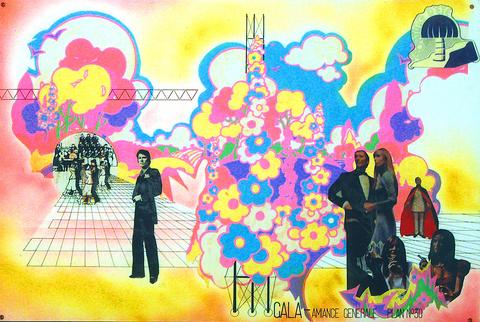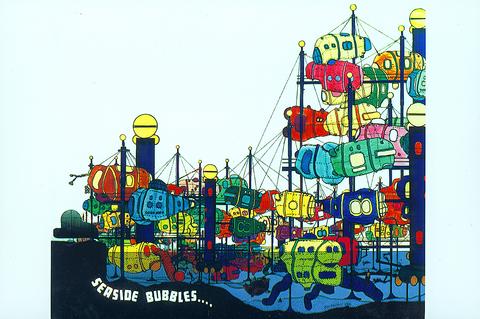Nowadays business deals have architects. Government policies have architects. There are even architects of sports victories. But architecture hasn't always permeated social consciousness, nor language.
An exhibition that opened yesterday at the Taipei Fine Arts Museum (TFAM), Archigram: Experimental Architecture 1961-1974, looks back to a major British movement that opened up architecture in these new ways and also helped define a 1960s futuristic aesthetic applied by others to Bond villains' headquarters, Monty Python's psychedelic animation and the Beatles' Yellow Submarine.
Archigram was founded as a magazine in 1961 by six London architects and then went on to spawn a movement. The magazine's pages were filled with manifestos, collaged space comics and fantastical drawings of an untold number of architectural projects, not one of which was ever built. It was a mod revolution that wanted to subvert stodgy urban landscapes with "gasket homes," "seaside bubbles," "underwater cities" and even an oil platform to be placed above Trafalgar Square.

PHOTO COURTESY OF TFAM
"We were designing non-houses, non-cities, non-building, non-places," said Peter Cook, one of Archigram's four surviving members and one of three in Taipei for the show's opening.
The designs were "anti-projects," and by the late 1960s they were part of the aesthetic and ideology of the "anti-establishment" movement. As architecture, the designs were, by and large, so imaginative that they were unbuildable. But they were imbued with a desire to dissolve cities, their existing hierarchies and their concrete exoskeletons. The term "archigram" was created by combining "architecture" with "telegram" and implied mobility, the lack of which they saw as an urban flaw to be rectified. So they invented "walking cities" that had legs and could move, "plug-in cities" that were interchangeable and "expendable place pads" as temporary, ad hoc homes. Drawings often called on materials that were inflatable, collapsible and not there when not needed. It was a vision of a society in flux.
In TFAM's galleries, these ideas are displayed in the form of more than 300 drawings, 14 architectural models and two extensive installations. Cook called it the second largest exhibition they've ever held in more than a decade of touring with their collection. One installation recreates a never-built 1969 design that fills a gallery with a Teletubby-like setting of astroturf, plastic flowers and inflatable dome homes. The second is a barrage of projected images, including a dozen slide projectors, video projectors and four television monitors.

PHOTO COURTESY OF TFAM
Much as American pop art is credited with bridging the gap between art and media, Archigram is credited with recognizing the confluence of architecture and advertising. (Imagine, for example, New York's Times Square or the Taipei Main Station MRT complex without ads ? it's virtually impossible because the ads are so central to what they are.)
Archigram member Michael Webb, also in Taipei for the opening, said that one of the things they realized was that "the labelling no longer applies," because in a dynamic environment, spaces can be used for anything. Advertisers discovered this long ago. As an example, Webb brought up the example of a New York commuter, a lawyer, who in a New York Times article claimed to actually enjoy the hours of traffic jams on his weekend commute because by employing a cell phone and a laptop computer sitting next to him in the passenger seat, it was the only time he could work without interruption.
"So you have this fellow doing all his work in an SUV, and still they build these office buildings everywhere. It doesn't work anymore, and it's still happening," said Webb.
"That's why we think the spirit of Archigram is still very much alive."
Archigram is on display through June 8 at the Taipei Fine Arts Museum (台北市立美術館) located at 181, Sec. 3, Chungshan N. Rd. (北市中山北路三段181號). Hours are 9:30am to 5:30pm Tuesday to Sunday.

While Americans face the upcoming second Donald Trump presidency with bright optimism/existential dread in Taiwan there are also varying opinions on what the impact will be here. Regardless of what one thinks of Trump personally and his first administration, US-Taiwan relations blossomed. Relative to the previous Obama administration, arms sales rocketed from US$14 billion during Obama’s eight years to US$18 billion in four years under Trump. High-profile visits by administration officials, bipartisan Congressional delegations, more and higher-level government-to-government direct contacts were all increased under Trump, setting the stage and example for the Biden administration to follow. However, Trump administration secretary

A “meta” detective series in which a struggling Asian waiter becomes the unlikely hero of a police procedural-style criminal conspiracy, Interior Chinatown satirizes Hollywood’s stereotypical treatment of minorities — while also nodding to the progress the industry has belatedly made. The new show, out on Disney-owned Hulu next Tuesday, is based on the critically adored novel by US author Charles Yu (游朝凱), who is of Taiwanese descent. Yu’s 2020 bestseller delivered a humorous takedown of racism in US society through the adventures of Willis Wu, a Hollywood extra reduced to playing roles like “Background Oriental Male” but who dreams of one day

Gabriel Gatehouse only got back from Florida a few minutes ago. His wheeled suitcase is still in the hallway of his London home. He was out there covering the US election for Channel 4 News and has had very little sleep, he says, but you’d never guess it from his twinkle-eyed sprightliness. His original plan was to try to get into Donald Trump’s election party at Mar-a-Lago, he tells me as he makes us each an espresso, but his contact told him to forget it; it was full, “and you don’t blag your way in when the guy’s survived two

Burnt-out love-seekers are shunning dating apps in their millions, but the apps are trying to woo them back with a counter offer: If you don’t want a lover, perhaps you just need a friend? The giants of the industry — Bumble and Match, which owns Tinder — have both created apps catering to friendly meetups, joining countless smaller platforms that have already entered the friend zone. Bumble For Friends launched in July last year and by the third quarter of this year had around 730,000 monthly active users, according to figures from market intelligence firm Sensor Tower. Bumble has also acquired the